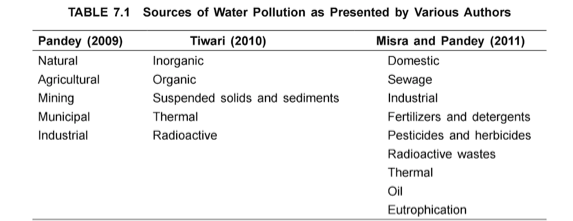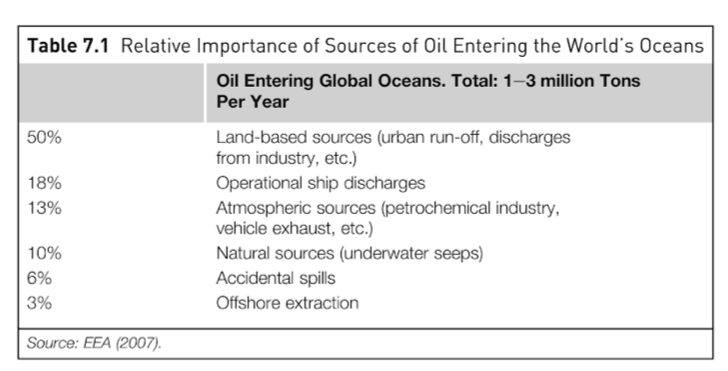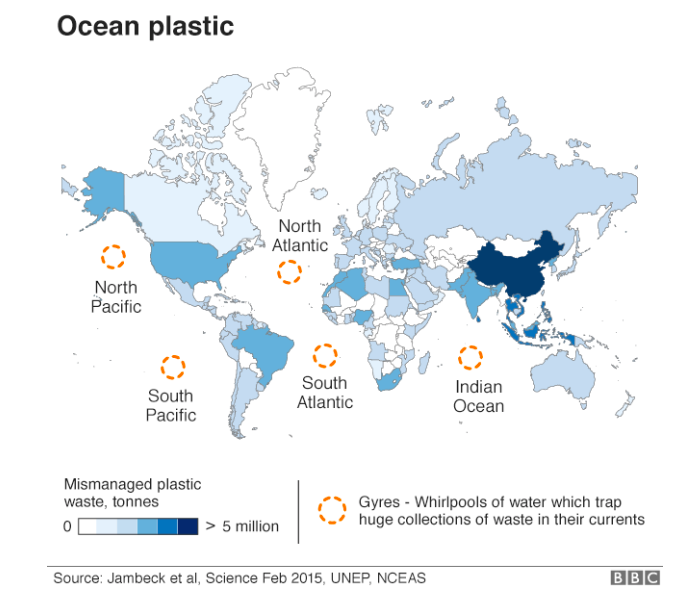The issue of marine pollution is one of the most acute in the environmental sciences. The overall condition of the ocean areas has adverse effects on the drinking water, as well as aquatic flora and fauna. By examining sources, types, pathways, and status of water contamination in the context of the World Ocean, it is clear that most marine pollution caused by human actions, especially the mismanagement of plastic debris.
Main Pollutants
Contamination of the World Ocean is a result of gradual water pollution on all levels, starting from the small streams, then, rivers, seas, and oceans. Sources of marine pollution have numerous classifications, depending on the author’s interpretations (see table 1). Primary origins include, but are not limited to, natural, industrial, agricultural, and oil contamination, later explained in this report. Natural marine pollution happens when rain caries aerial contaminants, such as dust and gas, to the water.

Examples contain phosphorus, ammonia, and nitrogen washed into the ocean through currents, streams, and snow. Industrial pollution occurs when factories dump products of manufacturing waste, such as acids, detergents, and chemicals, in the water bodies. Closely connected to industrial pollution is agriculture, another significant source of water contamination. Fertilizers, insecticides, and pesticides used in farming are frequently washed away in the water bodies: from streams to rivers, to seas, and, ultimately, to the ocean.
Oil spills account for the high percentage of marine pollution, as well. Oil discharge happens as a result of the accident, offshore exploration, leakage of the tankers, and other sources (see table 2). Notwithstanding the variety of sources of marine pollution, primary origins are caused by human interventions.

Types
Types of ocean pollution are closely connected to their sources. Major examples covered in this report include eutrophication, thermal, plastic, and sewage pollution. Eutrophication refers to the process, wherein products of sewage, organic
materials, and pesticides release P and N, increasing the photosynthetic activity and amount of excessive harmful bacteria in the water. With domestic and industrial pollution as its source, sewage contamination remains a significant issue in coastal areas. Similar to eutrophication, domestic and industrial waste produced in urban areas, dumped in the water bodies, carry various viruses and pathogens.
Another example of marine contamination caused by human intervention is thermal pollution. It occurs as a result of discharges from the nuclear reactors and power plants on the coastline, which deplete oxygen and raise the temperature of the water. Despite the profound adverse effect of sewage, thermal, and eutrophication pollution on the water bodies, plastic contamination has the most negative consequences on the World Ocean.
A large amount of mismanaged plastic debris is trapped in the whirlpools of water in three out of 4 oceans (see fig.1). After being washed in the sea, litter undergoes several chemical processes, converting to microplastics, which marine animals consume instead of food. The scope of the problem is so big that environmentalists now cannot control the intractable nature of plastics, present nearly everywhere: in the bodies of dead fish, distant beaches, and even Arctic ice.

Pathways
Pollutants may reach the sea in a variety of ways: through the air, direct discharges, and riverine inputs. Frequently, substances get washed away in the water through several channels simultaneously (see fig.2). The easiest pathway to control is direct discharge of waste (“point” source). Industrial pollutants washed away in the water bodies from land, waste from the ships, and power stations – all together undergo chemical transformations and remain stored within estuaries.

Strict legal regulations and adherence to environmental laws help to minimize the effect of “point” sources on marine pollution. Pollutants accumulated in the atmosphere appear much harder to control. Though usually, emissions from the factories remain in the gaseous state, small particles emitted in the atmosphere may dissolve with the rain droplets and land in the water.
The main risk associated with such pollution is a high number of toxic heavy metals, such as lead, being washed away in the ocean. With multiple pathways of marine contamination operating simultaneously, the current situation of the World Ocean pollution calls for urgent charges of the international community.
Status
The current situation of marine pollution casts a negative outlook on the safety conditions of the World Ocean. With various chemicals, products of organic, and non-organic waste being washed away in the water bodies daily, environmental scientists have little control over maritime pollution. For instance, scientists report approximately 15 different types of heavy metals, acids, sodium, and other poisonous chemicals spilled in the Baltic sea, as a result of an accident during the Chembaltic Project recently.
Direct discharges from the ships near the Dutch coastal zone lead to the accumulation of nonylphenol ethoxylates, while vessel emissions containing copper and arsenic are stored along the US seashore. Though the issue of maritime pollution from chemicals is no less significant, plastic debris washed away in the World Ocean appears to be a prevailing problem now.
Newest scientific estimations confirm that there are approximately ten tonnes of plastic only in the North Pacific Ocean, with 80% of the litter coming from the land. From what is known, plastic debris hurts one-quarter of all marine mammal species, one-third of seabirds, and approximately 90% of sea turtles. To minimize the horrific consequences of plastic mismanagement, the international community implements innovative policies aimed at environmental protection.
Ultimately, the issue of maritime pollution poses numerous risks for the environment today. Pollutants washed away in the seas have adverse effects not only on the overall condition of the World Ocean but also on the safety of aquatic animals and people. A brief overview of the types, sources, pathways, and current situation of maritime pollution provides sufficient evidence to argue that human interventions, in particular, plastic mismanagement, are a significant cause of water contamination.
Bibliography
Beiras, Ricardo. Marine Pollution: Sources, Fate, and Effects of Pollutants in Coastal Ecosystems. Amsterdam: Elsevier, 2018.
Frid, Chris, and Bryony A. Caswell. Marine Pollution. Oxford, UK: Oxford University Press, 2017.
Nair, Milind Mohan, and Santosh Kumar Dubey. Marine Pollution and Microbial Remediation. New York: Springer, 2016.
Sigler, Michelle. “The Effects of Plastic Pollution on Aquatic Wildlife: Current Situations and Future Solutions.” Water Air Soil Pollut 225, no. 2184 (2014): 1-9. Web.
Sulphey, M. M. and M.M. Safeer. Introduction to Environment Management. New Delhi, India: PHI Learning Pvt. Ltd., 2017.
Tomero, Victoria and Georg Hanke. “Chemical Contaminants Entering the Marine Environment from Sea-based Sources: A Review with a Focus On European Seas.” Marine Pollution Bulletin 112, no. 1-2 (2016): 17-38. Web.
Trowsdale, Alison, Tom Housden, and Becca Meier. “Seven charts that explain the plastic pollution problem.” BBC News. Web.